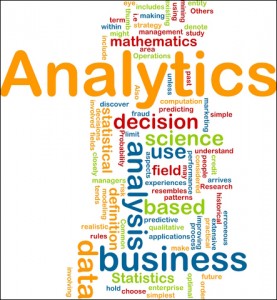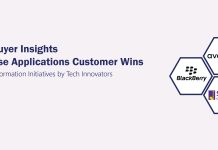There has been a lot of talk about the merits of business analytics, which is a cut above what business intelligence can do, but we will get to that in a minute. What matters is that we are at the tipping point of a new way of gathering intelligent data, aggregating and cleansing loads of them, and finally making sense of the obvious and not-so-obvious insights for planning and forecasting purposes through role-based reporting.
For more than a decade, much of the growth of the business Intelligence software market has been about helping large organizations manage massive amounts of data, querying them with data-mining tools and generating sophisticated dashboards that show visually stunning results ranging from complex key performance indicators to simple-to-understand metrics.
The Big Data phenomenon is just that. After years of collecting petabytes of data, many large enterprises now have access to anything they want to know about their customers. Apple is said to be beefing up its storage capacity to the tune of 12 petabytes in order to manage the video download of its customers.
Simultaneously these multinationals are unleashing a torrent of data that none of their customers can decipher intelligently. Recently a CIO spoke of the feed for its business data subscribers now reaching 700,000 updates per second, an output that is beyond human capacity to absorb, let alone doing anything with it.
SMBs Embrace Business Intelligence
Meanwhile, small and midsized companies have become the next battleground for business intelligence software vendors vying to bring enterprise-class analytics and reporting tools to the masses, an outcome that could have multiplying effects to the applications market.
As shown in the following graphic, SAP, which has already held nearly a quarter of the $7-billion BI market worldwide, is making that force multiplier more evident.
Worldwide Market Shares of Top 5 BI Vendors, 2009-2010
Earlier this month SAP introduced SAP Crystal Server 2011 and the 4.0 release of SAP BusinessObjects Edge Business Intelligence. The products, which can be purchased as a bundle or separately, offer improved data search, drill-down and dashboard viewing capabilities. Additionally SAP BusinessObjects Edge 4.0 extends support to mobile users, while its Event Insight function allows SMEs to monitor business scenarios in real time and respond to market changes accordingly. Its text data analysis feature even allows customers to analyze what’s being said about their products and services on social media sites such as Facebook and Twitter.
Such enhancements are instrumental in helping small and midsized companies make smarter decisions in response to shifting market conditions including whether and when they should adjust their inventory levels, channel promotions or marketing expenses based on real-time data. By leveraging SAP’s on-demand delivery model, these users can either implement these BI solutions without the help of their IT departments or proceed with these projects in a compressed timeframe by taking advantage of SAP rapid deployment options.
In addition to selling the products directly, SAP has been working with a growing army of OEM and reseller partners to make BI as ubiquitous as possible. For example, Syspro, which has secured a base of 14,500 mid-market customers in such verticals as consumer and packaged goods, life sciences and manufacturing, is incorporating many of the latest dashboard capabilities from SAP Crystal Server to boost the usability of its ERP applications by making it easier for business users from CFOs to purchasing managers generate tailored reports for their day-to-day responsibilities.
For Syspro, the combined ERP and BI software for functions like inventory management, executive dashboard and what-if scenario visualization has galvanized support for its products, while delivering tangible value for users that now have easy access to real-time information. For example, Honest Tea, a beverage maker, cited its ability to halve its inventory levels because of the availability of such useful information by running the Syspro system.
Pentaho, Tableau, Qliktech Join The Fray
SAP is not the only BI vendor eying the SME market with great interest. Pentaho, which has made its name in the open-source BI marketplace, introduced Pentaho BI 4 Enterprise Edition in June. One of the key targets is non-technical business users who can use the new product to create highly formatted, interactive reports with zero training or involvement from the IT department.
While Pentaho has been used by big organizations like Sheetz and Swissport, it has also attracted hundreds of small and mid-sized commercial customers, not to mention the viral effects on those who have been using its BI products for free at a rate of one download every 30 seconds.
Tableau is another fast-growing BI vendor that has made its name by lowering the barriers of entry with Tableau Public, a free service that anyone can use to create and publish interactive data visualizations to the Web. Since its launch in February 2010, more than 10 million Web pages with Tableau Public data visualizations have been served.
Elsewhere, Qliktech has seen its customer count soaring to more than 18,000 from 13,000 in 2009, after making small and midsized companies a major plank of its BI strategy. Quadax, one of Qliktech’s customers that sells its own software into life sciences vertical, was able to implement the mobile BI product from Qliktech in six weeks and now 110 Quadax users use their iPad to access analysis for managing payer reimbursement metrics and trends from clinical laboratories, vastly improving the quality of data they receive for better support of their clients.
Qliktech also OEMs its BI products to vendors such as Deltek, which specializes in business applications for small and midsized customers including 1.8 million users representing more than 14,500 firms in architecture, engineering and construction as well as government contracting space.
Business Analytics Becomes The Holy Grail
When one tabulates the potential of these vendors and the new and recurring revenues they generate from customers and reseller and OEM partners, the market for business intelligence software is expected to grow from $7.3 billion last year to $10.4 billion by 2015.
But the Holy Grail may well be the business analytics market, which includes not just Business Intelligence, but also features such as enterprise information management for data aggregation and cleansing and enterprise performance management for planning and forecasting.
Moreover SME customers are turning to business analytics to complete tasks like applying analytics to Web front-end in order to deliver role-based reporting. In order for that to happen, more intelligent data will need to be layering on top of the analytics one gets from monitoring eCommerce sites or other customer-facing channels like retail stores. The analytics could become more useful if one can ascertain the impact on inventory, service and staffing levels, all of which will require bringing in additional software features like supply chain, customer relationship, and HR management, boosting the total addressable market for business analytics to new heights.
Instead of a $10-billion market opportunity, the worldwide business analytics software opportunity could reach $30 billion by 2015, according to our latest estimates. Based on the direction that these vendors are headed and the keen interest among small and midsized companies, a user community that has barely begun leveraging business analytics as a competitive edge, the payoff for vendors and other key stakeholders is real and unmistakable.
The question is whether any one has the right formula of delivering smart and high-impact business analytics solutions and tying them together in a neat and attractive package for any business to realize and achieve the predictable and desirable outcome.






